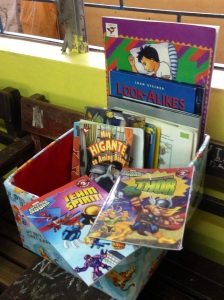“Buti pa sa school, maraming kwento. (In school, we have lots of stories.)“
One of the things that has kept my spirits up the past three weeks is seeing my students enjoying our classroom library. During the first week of classes, I would bring my books to school and take them home each day. We only have one cabinet in the room and it’s full of other things already because we share it with a Grade 4 class in the morning. One afternoon, a student approached me and handed me a gift-wrapped box. I asked him what it was for and he said, “Para sa classroom library po natin. (For our classroom library.)“
I was surprised and touched. If the Child Protection Policy did not forbid us from hugging kids, I would’ve hugged him! My students were happy and one even said, “Ayan, mas madali na kumuha. (It’s easier to get books now.)” And from then on, the books were no longer just Teacher’s books – they belonged to our class.
“She reads books as one would breathe air, to fill up and live.”
Stories, for me, are like strings that weave human experiences together – they allow us to share our humanity and at the same time show us countless possibilities. Lisa Bu, in her TED Talk entitled How Books Can Open Your Mind, said:
“Books have given me a magic portal to connect with people of the past and the present. I know I shall never feel lonely or powerless again. Having a dream shattered really is nothing compared to what many others have suffered. I have come to believe that coming true is not the only purpose of a dream. Its most important purpose is to get us in touch with where dreams come from, where passion comes from, where happiness comes from. Even a shattered dream can do that for you.“
This is probably the gift I want to leave with my students – to get in touch with their dreams and how to make them come true. I believe the best way I could do this is by sharing stories with them and sharing their stories to everyone.
 “…writing is an extension of speech, that behind every written word there is a human voice speaking, and that reading is the way to hear what those voices are saying.” – John Holt
“…writing is an extension of speech, that behind every written word there is a human voice speaking, and that reading is the way to hear what those voices are saying.” – John Holt
Our class goal is: Kayang-kaya kong abutin ang 100%! (I can reach 100%!). This doesn’t translate to just their scores but it also means doing their best in everything they do. Working with children in the lower sections means being with those who have been labeled as low achievers, balik-aral (students who stopped studying and went back to school after x number of years), non-readers, troublemakers, and the labels go on. Changing their current mindset about what they can and cannot do is definitely challenging.
As a class, we have decided that we want to work towards this goal and that we want to share our story about it. An amused student said, “Ma’am, sana sumikat ang kwento natin! (Ma’am, I hope our story becomes famous.)” And in my head, the lingering thought was – why not?
Starting last week, we’ve documented what we’ve done in the classroom so far to reach 100%:
Even if my students are struggling to write, I wanted them to share in the experience – I would take their pictures and ask them to come up with the words to accompany the photos. In this way, we are all authors of the same story.
How can YOU be a part of their story?
Many of you have expressed your support – whether it is through words of encouragement or tangible materials, the kids and I are very grateful. They know about you and I tell them that many of you are excited to see what they can become at the end of the year. I think that in some way, it does lift their spirits to know that there are people outside rooting for them.
But like I said in my previous post, there are many ways to help and share in this experience – Kayang-kaya natin abutin ang 100%!
The kids and I are looking forward to making YOU a part of our story. 🙂


Thank you for sharing your stories. You just don’t give us unique and creative ideas for our (future) classes, but you also inspire us to be more caring and thoughtful teachers to our students. 🙂
LikeLike
Thank you! I hope you get to share your own stories soon. 🙂
LikeLike